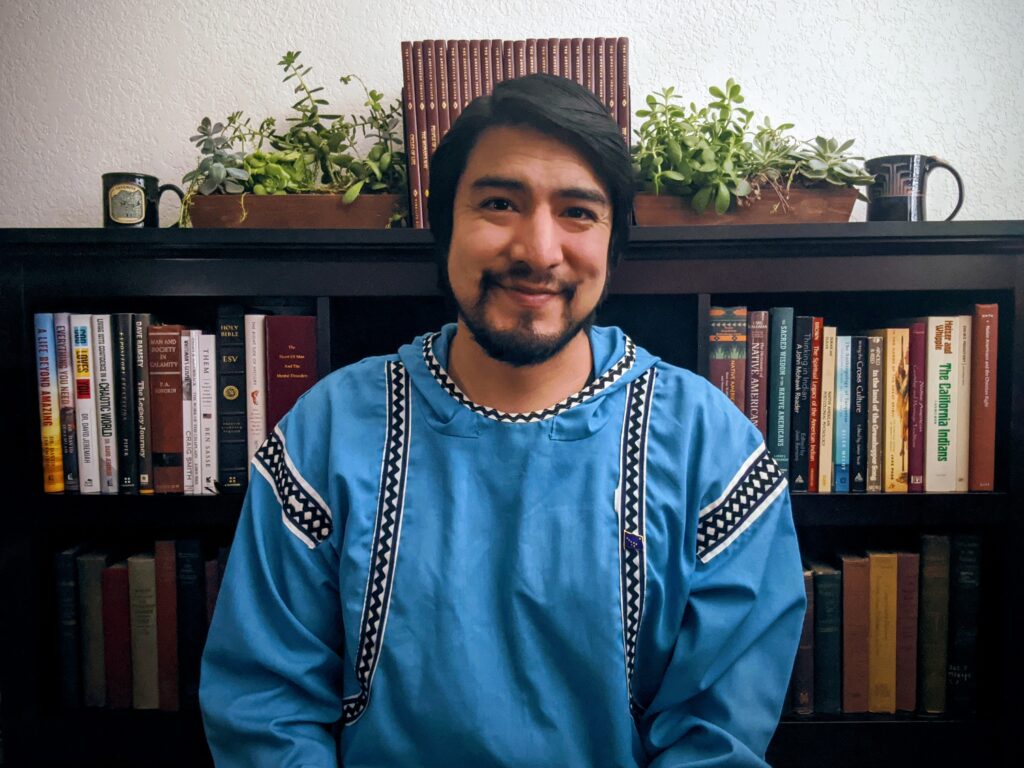
Ethan “Red Eagle” Lawton, native name Qawaaghhpak (Kah-waugh-kak-buck), or Red Eagle, holds the position of Tribal Liaison and Associate Planner at SHN. Throughout his career, he has collaborated with over 50 Tribes, journeyed to more than 100 Reservations and Tribal Lands, and engaged with Tribal members from over 200 Tribes.
Ethan’s ancestral heritage encompasses a rich blend of four Nations. He is a descendant of the Iñupiat, Sioux (Lakĥóta), Diné (commonly known as Navajo – Bitterwater), and Tohono O’odham (formerly known as Papago), with whom he is an enrolled member. Born in Anchorage, Alaska, he spent a portion of his childhood in Phoenix, Arizona. Following that, he pursued his college education in San Diego before settling in McKinleyville, California, where he resided for ten years.
Ethan’s educational journey led him to pursue an Interdisciplinary Bachelor of Arts degree. His intercultural studies concentration contributed to developing his collective perspective, while his focus on counseling psychology equipped him with an individual viewpoint.
Why and how did you end up becoming a Tribal Liaison?
I have always been interested in bridging divides and understanding differences. As a result, every aspect of my involvement has revolved around this pursuit. Whether it’s delving into intercultural studies to uncover both the similarities and differences, exploring the realms of psychology and counseling, or engaging in Tribal liaising, each endeavor has contributed to this overarching purpose. Even my work in planning incorporates elements of understanding similarities and differences. It manifests in various dimensions, be it cultural or planning, as I aid the Planning Commission in navigating this journey alongside the public and Tribal communities. Understanding the intricacies of the project, the lead agency, and the involved Tribes, allows me to identify the common ground and divergences. Though these may encompass different facets, the guiding principles remain consistent: comprehending what is similar and what is different and determining the most articulate path forward.
If you were to teach tribal planning as a course, how would you go about it?
If I were to teach a course on Tribal planning, my approach would involve comparing the values and priorities between Western culture and Tribes. For instance, a notable distinction is the authoritative weight of verbal vs. written. In Western cultures, written documentation and codified laws dictate priority, while in Tribal cultures, oral traditions are not only a voice of and for the people but of those who have come before as well. Thus, restructuring perspectives on the purpose, intent of laws, and path to achieving them becomes essential. Another contrasting aspect is the perspective on land. Western culture views land as something that individuals can own and, hence, referred to as property. However, in Tribal culture, land is often seen as a shared entity, not something that an individual can own but rather something else that is a part of us, and we are a part of it. Even at the most fundamental level, the differences are apparent.
Therefore, I would commence the course by deconstructing preconceived notions of Western planning itself. This process would lay the foundation for understanding how Tribal involvement within planning is vital.
Do tribes share information and learn from one another?
In general, Tribes collaborate when it proves advantageous. Nevertheless, each Tribe preserves its unique identity and follows its distinct path towards self-development. This journey entails various dimensions, including the growth of Tribal government, the expansion of departments, and the nurturing of cultural heritage. Partnerships are formed in diverse capacities within each of these arenas.
Can you share some examples of your work and how it made a difference?
While working on a land-use plan, I collaborated with a Tribe that was acquiring and developing various parcels of land for various initiatives. It became evident that the consultation effort, without an overarching direction, could prove negligible or, worse, antagonizing. I worked closely with the Tribe, engaging with the Tribal council, who held the political authority, consulting with the departments responsible for day-to-day tasks, and seeking input from the Tribal members who were the primary beneficiaries of the project. We facilitated discussions, comparing different desires and concerns. The Tribal Council aimed for a unified government building, while the departments preferred a campus-like setting with separate entities. Balancing these needs, desires, and concerns, we went through a comprehensive process to capture and prioritize ideas. The outcome was a land use plan that integrated all these perspectives, ensuring a comprehensive approach and maximizing the project’s potential for success.
In another instance, I was involved in an AB 52 consultation between a city and a Tribe regarding a development proposal that could impact cultural resources. Tensions ran high, and the Tribe expressed their fury at the meeting. The city was unsure how to move forward, leading to a stalemate. Sensing the need to address the situation, I interjected and acknowledged the anger— thanking them for sharing and reassuring them that this was the place for expressing concerns and active listening. By emphasizing the purpose of the consultation, the tone of the meeting transformed. It opened up a path for constructive dialogue and helped mend the relationship between the city and the Tribe. This approach involved reconciling differences and finding common ground to facilitate progress.
In both instances, my work involved facilitating discussions, balancing differing perspectives and guiding the parties involved toward a shared understanding. By considering diverse viewpoints, capturing priorities, and promoting articulate communication, I aimed to provide a path forward that respected the needs, desires, and concerns of all those involved.
What are SB 52, Section 106, and AB 52?
These legislations primarily focus on Tribal consultation. They establish the purpose and intended outcomes of consultations between a lead agency and a Tribe or Tribes. However, the specific process of conducting these consultations is not explicitly defined in the laws. This is because the legislators recognized that each project, Tribe, and relationship between the lead agency and Tribes is unique. Consequently, it becomes the responsibility of the project team to determine the consultation process. This is where most complications arise. Consultation, as required by the law, is defined as formal consultation, while consultation exceeding the legal requirements is typically considered informal consultation. Formal and/or informal consultation is not based on governmental agency interactions, record keeping, or on formal understanding, which often leads to confusion.
The consultation process can generally be divided into four phases, which can occur in a single meeting or a series of meetings. The first phase is the pre-consultation stage, which sets the foundation for the consultation process. Unfortunately, this crucial phase is often overlooked, contributing to confusion among both the lead agency and the Tribe(s). The second phase involves the lead agency communicating the details of the project to the Tribe. In the third phase, the Tribe conveys the potential impact of the project on cultural resources, Tribal cultural resources, and trust assets to the lead agency. The final phase entails exploring alternatives and developing mitigations, involving contributions from both the Tribe(s) and the lead agency. While this serves as a general framework for consultation, the actual process may vary depending on the specific relationship between the Tribe(s) and the lead agency.
It is important to note that the law sets forth the minimum requirements for consultation and anything beyond formal consultation should be collaboratively discussed and determined by both the lead agency and the Tribe.
Is there a need for tribal liaisons?
There are two aspects to consider in answering this question. Firstly, the importance of addressing concerns cannot be overstated. Let’s take the example of a significant wind energy project proposed in northern California that had the potential to fulfill 50% of the county’s energy needs. Initially, the Tribal consultation process began positively, but subsequent changes to the project rendered it subpar. As a result, the Tribe voiced opposition, ultimately leading to the project’s failure despite its initial prospects. The deterioration of the relationship between the lead agency and the Tribe, along with its impact on public opinion, highlights the significance of robust Tribal consultation efforts. It underscores the need for effective communication, addressing concerns, and developing appropriate mitigations.
The second aspect relates to the evolving roles and authority of Tribes. As Tribes continue to grow, there is a transition taking place wherein they undertake more control over their own affairs. Previously, the Bureau of Indian Affairs (BIA) fulfilled many functions that Tribes now handle independently. This shift results in reduced reliance on state or federal efforts and increased reliance on the Tribe itself. This transition necessitates the cultivation and strengthening of relationships between the lead agency and the Tribe. For instance, as Tribes establish their Tribal Historic Preservation Officers (THPO), the need for the State Historic Preservation Officer (SHPO) decreases. Recognizing the expertise within the Tribe, it becomes essential to foster effective correspondence and relationships with the Tribes themselves.
In summary, the need for Tribal liaisons is apparent in both ensuring the proper addressing of concerns through robust consultation processes and adapting to the evolving roles and authority of Tribes as they grow.
How can APA help with creating awareness about tribal and indigenous planning?
APA’s Tribal and Indigenous Planning Division is instrumental in promoting awareness and taking action on planning issues concerning Tribal and indigenous communities, planners, nations, and their non-tribal partners.
To create awareness, effective communication is vital. Conducting interviews like this one is a positive step forward. Additionally, organizing sessions and brown bag discussions focused on Tribal planning and related issues can facilitate meaningful dialogue and knowledge sharing. These efforts should be undertaken at various levels, including the local, regional, and state levels, to ensure a broad reach and engagement with diverse stakeholders.
By actively engaging with Tribal and indigenous planning topics through dedicated divisions, communication initiatives, and knowledge-sharing platforms, APA and planners can significantly contribute to creating greater awareness and understanding of Tribal and Indigenous planning within the planning community and beyond.
What do you enjoy doing when not working?
In my spare time, I like to backpack, take road trips, visit national parks, try new foods, do landscape photography, watch movies, play ultimate Frisbee, and spend time with family and friends. I am a lifelong learner and love to read, study, and learn.

Interviewer Dhawal Kataria, AICP, RSP, is a transportation planner at Kittelson & Associates and a guest writer for Northern News. All interviews are edited.
